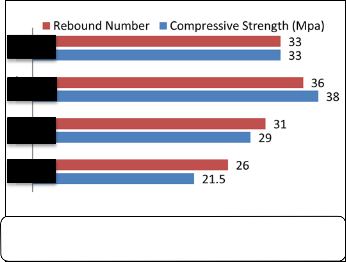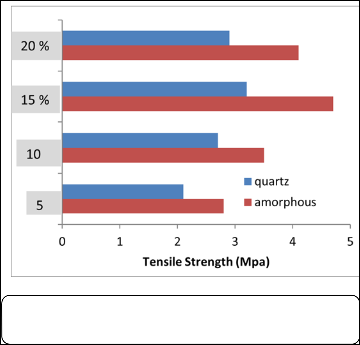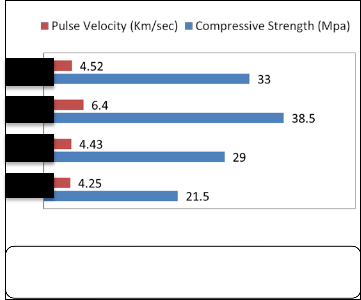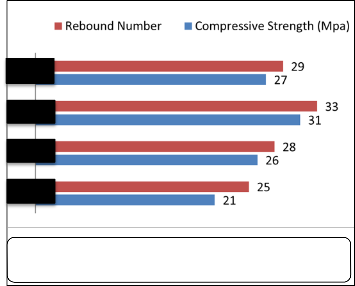International Journal of Scientific & Engineering Research, Volume 5, Issue 6, June-2014 1437
ISSN 2229-5518
Comparison between the properties of Amorphous and Crystalline - Nano SiO2 additives on Concrete Rami Joseph Aghajan Sldozian
![]()
Abstract In this paper, the study included the comparison between amorphous silica and crystalline silica (quartz), and with nano scale size, two types of silica was added to concrete by ratios (5%, 10%, 15%, and 20%) as a replacement by the weight of cement. Destructive and non-destructive tests was conducted on the samples, the results show in destructive test the compressive and tensile strength increase in 15% ratio in both kinds of silica, but in amorphous silica was high than in quartz. The results of non-destructive tests show in (Schmidt Hammer) the 15% ratio in both kinds of silica show high hardness than other ratios. Ultra sonic (pules velocity) test, noted the better quality was in 15% ratio in amorphous silica and also show fastest pules velocity.
Keywords ---- Concrete, Cement, Nano-SiO 2 , Ultrasonic, Schmidt Hammer, Tensile strength, Compressive strength.
—————————— ——————————
Nano materials have attracted much scientific interest due to the potentially new performance of the particles in nanometer (10-9 meter) scale. The nano scale particles can result in dramatically improved or different properties from conventional grain-size materials of the same chemical composition. Hence industries can re- engineer many existing products and design novel products that function at unprecedented levels. Nano particles can make traditional building materials stronger and harder, giving them enhanced ductility and formability. However, the present applications of these materials are mainly limited to produce antiaging, antiseptic, purified air composite paint or other ecological building materials using nano-TiO2 , nano-SiO2 or nano- Fe2 O3 . There is little research on mixing nano-particles in cement-based materials [1]. In view of the above- mentioned, the aim of the study was to investigate the influences of nano-SiO2 in cement mortars. Silica fume in micro scale and in powder form with SiO2 ranging from
85% to 95% has been used either as a partial replacement for cement or as an additive when special properties are desired. Many investigating the use of silica fume as a partial replacement for cement in combination with superplasticizer has shown a significant increase in the strength of concrete. The development of an ultra-high strength concrete was made possible by the application of DSP (Densified System containing homogeneously arranged ultrafine Particles) with superplasticizer and silica fume content. The amorphous or glassy silica, which is the major component of a pozzolan, reacts with calcium hydroxide formed from the hydration of the calcium silicates. The rate of pozzolanic reaction will be proportional to the amount of surface area available for reaction [2,3].
• Cement
![]()
Ordinary Portland cement manufactured by (tasluga factory \ Bazian) cement factory was used throughout this investigation. Table (1) and (2) show the physical and chemical properties.
Table (1) Chemical properties of the cement
IJSER © 2014 http://www.ijser.org
International Journal of Scientific & Engineering Research, Volume 5, Issue 6, June-2014 1438
ISSN 2229-5518
• Coarse Aggregate:-
![]()
The coarse aggregate that crushed to12.5 mm maximum size was used. It was obtained from AL - Nebai source, Table (4) show the sieve analysis.![]()
Table (4) Sieve analysis of coarse aggregate
Table (2) Physical Properties of the Cement
• Fine aggregate:-
![]()
AL-Ekadir in Karbala region sand was used as fine aggregate, Table (3) show the sieve analysis of fine aggregate.![]()
• Added two types of silica: - Amorphous and Crystalline SiO2. Was added (5%, 10%, 15%, 20%) by weight and the physical properties show in table (5), and chemical properties show in table (6). And (fig1) show X.R.D of amorphous and crystalline (quartz) silica.
Table (5) Physical Properties
Table (3) Sieve analysis of fine aggregate
Sieve Size (mm) | % Passing | % Passing according to limits of Iraqi Standard No. 45/1984 |
4.75 | 95 | 90-100 |
2.36 | 90 | 85-100 |
1.18 | 85 | 75-100 |
0.60 | 70 | 60-79 |
0.30 | 25 | 12-40 |
0.15 | 5 | 0-10 |
Fineness Modulus = 2.3 |
IJSER © 2014 http://www.ijser.org
International Journal of Scientific & Engineering Research, Volume 5, Issue 6, June-2014 1439

ISSN 2229-5518
X.R.D Quartz
• Concrete Mixing:-
![]()
The details of mix proportions are presented in Table (7). All mixes was adding silica as a partial replacement by cement weight content, and cast a samples as a cylinder mold (100×200) mm to compressive and tensile strength and cubic molds (150×150×150) mm to non-destructive tests.
Table (7) Details of the Mixes Used Throughout This
Investigation
X.R.D SiO2
X.R.D of Quartz and SiO2 Amorphous
![]()
(Fig 1)
Table (6) Chemical Properties
٭W/C : water/Cement ratio
• Mixing Procedure:-
Adopted concrete mix 1:2:3 in the casting process from each mix. a total of 3 cylindrical concrete specimens
100 mm in diameter and 200 mm high[4] and 3 cubic specimens 150×150×150 mm[5]. The molds were oiled properly for easy out sample and then fill the mold with three layers of the mixture and with each layer instills by tamping rod to ensure out the bubbles and distribution. After casting and finishing, the specimens were demolded after 24 hours of casting and then they were transferred to a curing tank placed at the laboratory temperature of 18 to
20ºC. The specimens were cured in the water tank for 28
days, and then dried in the air to be tested.
IJSER © 2014 http://www.ijser.org
International Journal of Scientific & Engineering Research, Volume 5, Issue 6, June-2014 1440
ISSN 2229-5518
• Compressive and Splitting tensile Strength:-

Compressive and Splitting tensile Strength was calculated from examination of the dimensions of the cylinder (100×200 mm) Concrete containing Quartz and amorphous silica, and ratios (5%, 10%, 15%, 20%) and the results are shown in Figure (2,3).
10%
Fig2. Show relation between compressive strength and ratio of amorphous and quartz silica
By comparison with sample without additives (20 Mpa) in compression and (2.6 Mpa) in tensile, Note from (Figures 2 and 3) that with adding silica increase compressive strength and splitting in both cases, by addition of quartz and amorphous silica, but observed that the compressive strength and splitting increases with adding two types of silica to the extent of 15%, and also note that the effect of silica with an amorphous structure was more in the concrete than the crystal structure of silica.
• Rebound number (Schmidt Hammer):-
The samples was tested non-destructive test by (Schmidt Hammer /Proceq Company ), where it is determine by rebound number (R) of hammer on the surfaces of cubic samples, and the tested take different places from the same sample and determine the average of rebound number, then knowing the compressive strength from the rebound number by the curve was gives with device. The rebound number of concrete sample without additives (24.5), and noted as show curve below in (Fig4), the rebound number of hammer was high in the ratio 15% compared with another ratio in amorphous silica, thus the compressive strength was high, that it is mean the hardness of concrete is good. And also noted that the ratio 15% of crystalline silica (quartz) show (Fig 5) high rebound number of hammer compared with another ratio, so the
15% ratio have high compressive strength. And with
compared amorphous silica with crystalline silica, noted the amorphous silica have higher rebound number and thus high compressive strength.
20%
15%
10%
5%
Fig3. Show relation between tensile strength and ratio of amorphous and quartz silica
(Fig 4) Relation between R with compressive strength of amorphous silica
IJSER © 2014 http://www.ijser.org
International Journal of Scientific & Engineering Research, Volume 5, Issue 6, June-2014 1441

ISSN 2229-5518
20%
15%
10%
5%
20%
15%
10%
5%
(Fig 5) Relation between Rebound number with compressive strength of quartz
(Fig 6) Relation between pulse velocity and compressive strength
of amorphous silica


• Ultra Sonic (Pulse Velocity):-
Samples tested by Ultrasonic (pundit lab – Proceq
Company) to determine the quality of concrete. The pulse velocity of concrete sample without additives is (4.24
Km/sec), and by determine the pulse velocity of concrete
that contain amorphous silica show increase the pulse
velocity by increase the additives, but noted that the high velocity was in 15% than the other ratio of amorphous silica as show in (Fig 6), also the pulse velocity of concrete have crystalline silica increase by increase the additives, and the high velocity was 15% than other additives (Fig 7). And the highest pulse velocity was in 15% amorphous additives. However, all the samples was good but the sample have
15% amorphous was excellent according to Neville, A.M. (Table 8) [6]
(Table 8) Classification of the quality of concrete on the basis of pulse velocity
20%
15%
10%
5%
(Fig 7) Relation between pulse velocity and compressive strength of quartz
Conclusion from this research, amorphous silica is active than crystalline silica in concrete mix, where amorphous silica show high mechanical properties and show high quality in non-distractive test than crystalline silica. And conclusion is the better added ratio is 15% in both type of silica, but the percentage of ratio15 % in
amorphous silica was higher than crystalline silica.
IJSER © 2014 http://www.ijser.org
International Journal of Scientific & Engineering Research, Volume 5, Issue 6, June-2014 1442
ISSN 2229-5518
1. Li, H., Xiao, H.-G., Yuan, J., and Ou, J. (2004). “Microstructure of cement mortar with nano- particles.” Composites Part B: Engineering,Vol. 35, pp. 185-189.
2. Mazloom, M., Ramezanianpour, A.A., and Brooks, J.J. (2004). “Effect of silica fume on mechanical properties of high-strength concrete.” Cement and Concrete Composites, Vol. 26, pp. 347-357.
3. Toutanji, H. A. and El-Korchi, T. (1995). “The influence of silica fume on the compressive strength of cement paste and mortar.” Cement
and Concrete Research, Vol. 25, pp. 1591-1602.
4. BS 1881-110:1983 Testing concrete. Method for making test cylinders from fresh concrete.
5. B.S. 1881: part 108: 1993 "Method for making Test Cubes from Fresh
Concrete, 1993
6. Neville, A.M., 1995,"Properties of Concrete", fourth edition, pp.631-
632
IJSER © 2014 http://www.ijser.org
International Journal of Scientific & Engineering Research, Volume 5, Issue 6, June-2014
ISSN 2229-5518
1443
l-EER ©2014